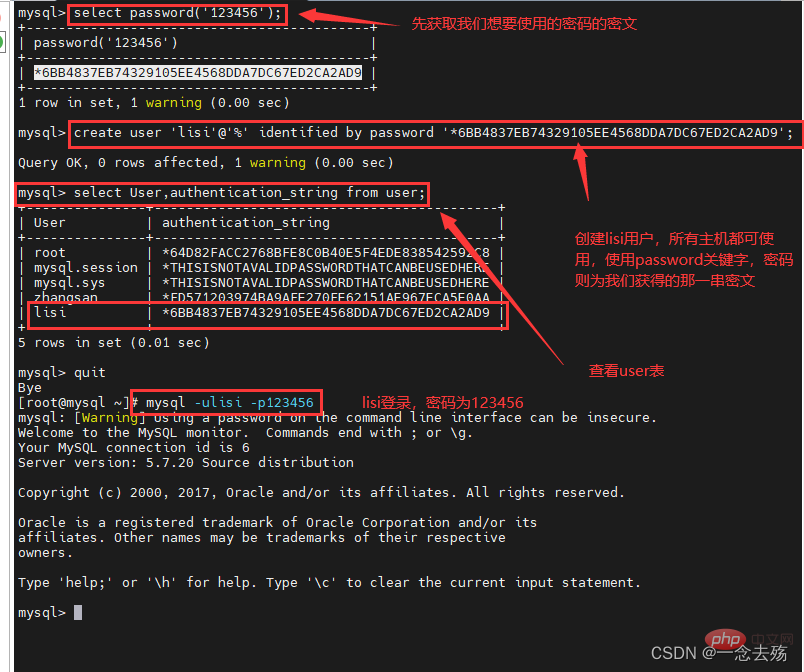rename user '旧用户名'@'旧主机名' to '新用户名'@'新主机名';
drop user '用户名'@'主机名';
Graphical examples analyzing MySQL user management
This article brings you relevant knowledge about mysql, which mainly introduces related content about user management, including creating new users, viewing user information, renaming users, deleting users, etc. Let’s take a look at the content below, I hope it will be helpful to everyone.
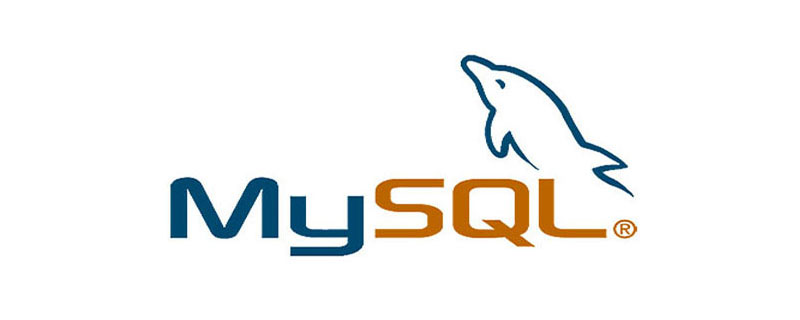
Recommended learning: mysql video tutorial
1. User management
##1.1 Create a new usercreate user '用户名'@'主机名' [identified by [password] '密码'];
Copy after login
create user '用户名'@'主机名' [identified by [password] '密码'];
- The user name needs no explanation, it is the account we use when logging in
- The host name specifies which hosts the user we create can be on To log in, you can use the IP address, network segment, and host name. Local users can use localhost. Allowing login from any host can be represented by the wildcard character %.
- identified by is translated as verification by..., which is the password. The password is divided into plain text and cipher text. The plain text is directly identified by plus 'password', and the cipher text is identified by password 'password' ', the password keyword is added.
- If you use a clear text password, enter the 'password' directly, and it will be automatically encrypted by Mysql when inserted into the database; if you use an encrypted password, you need to use SELECT PASSWORD('password'); to obtain the ciphertext first, and then add it in the statement Add PASSWORD 'Private text'; if the "IDENTIFIED BY" part is omitted, the user's password will be empty.
- Create user in clear text

 ##Create user in ciphertext
##Create user in ciphertext 
View the user table in the mysql library. It should be emphasized that only the root user can view this library. Normally Users do not have permission to query this library.
If we want an ordinary user to view this mysql library, we need to use grant for authorization. Note that authorization work can only be performed by the root user. 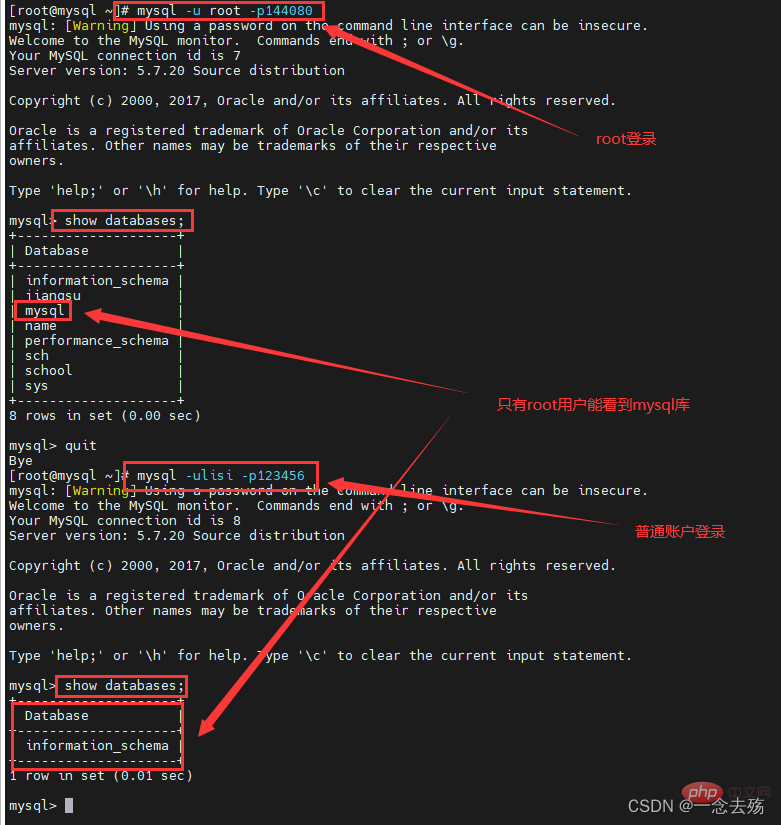
Remote login, that is, remote login to the local database from other hosts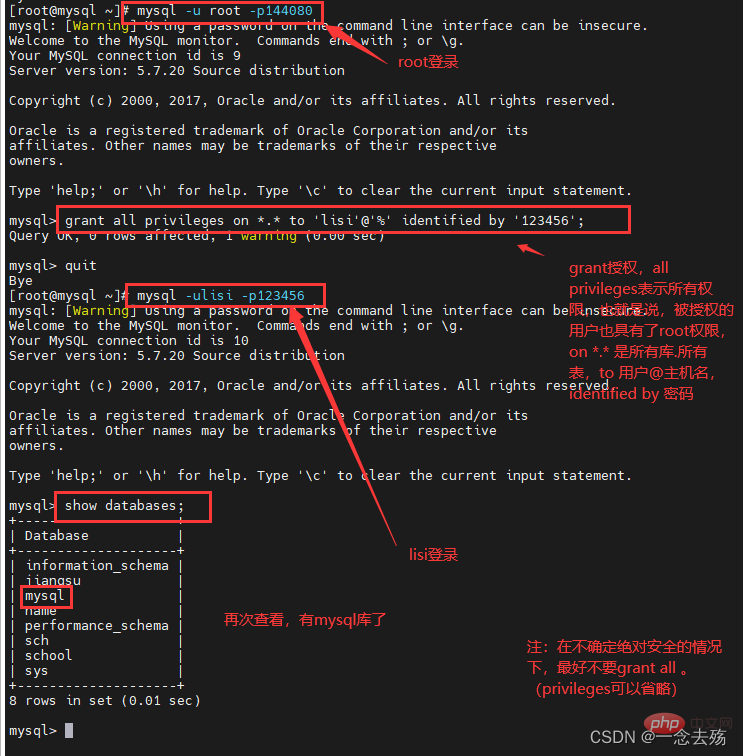
View the mysql.user table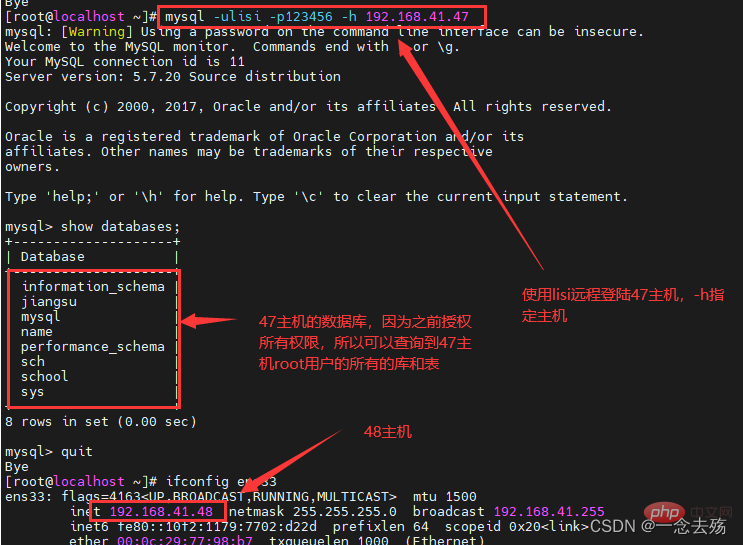
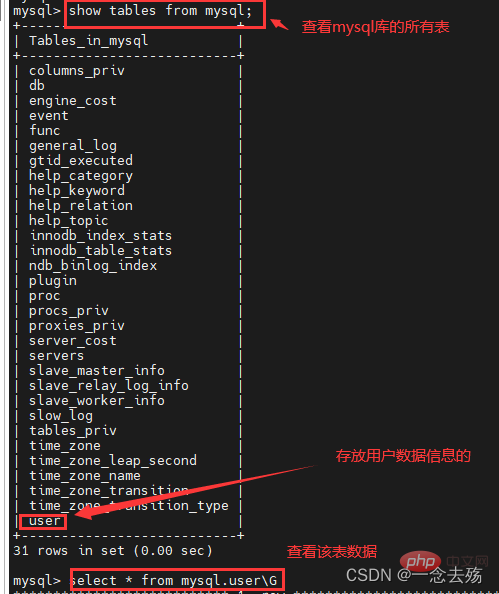

rename user '旧用户名'@'旧主机名' to '新用户名'@'新主机名';
Copy after login
rename user '旧用户名'@'旧主机名' to '新用户名'@'新主机名';
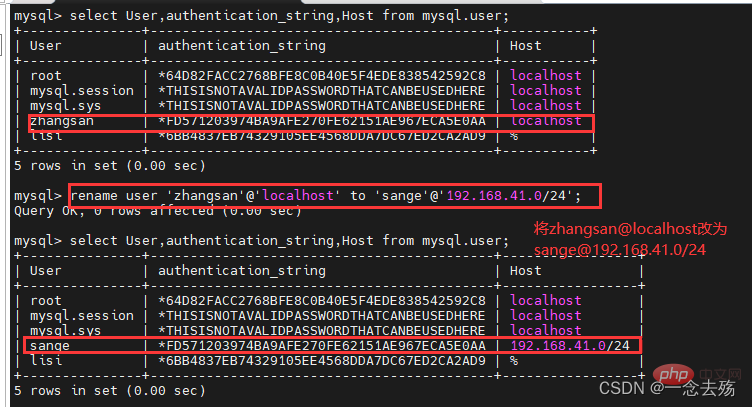

drop user '用户名'@'主机名';
Copy after login
drop user '用户名'@'主机名';
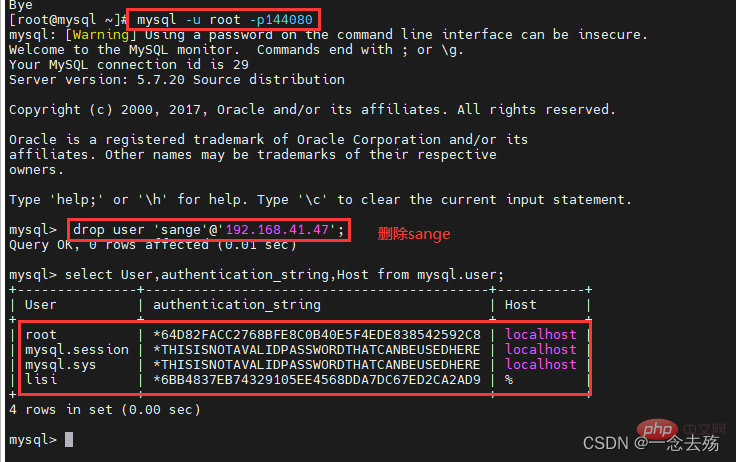
1. Modify current user password
set password = password('新密码')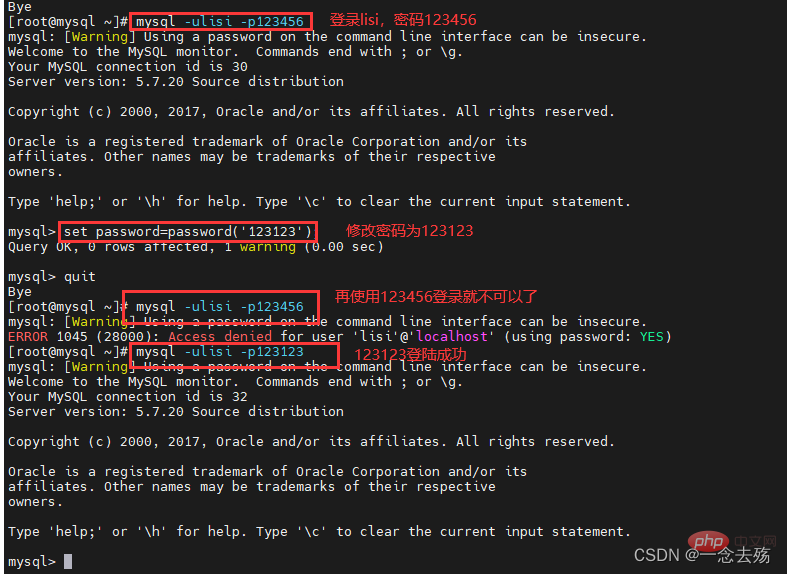 2. Change the password of other users
2. Change the password of other users
set password for '用户名'@'主机名' = password('新密码');普通用户是无法修改其他用户密码的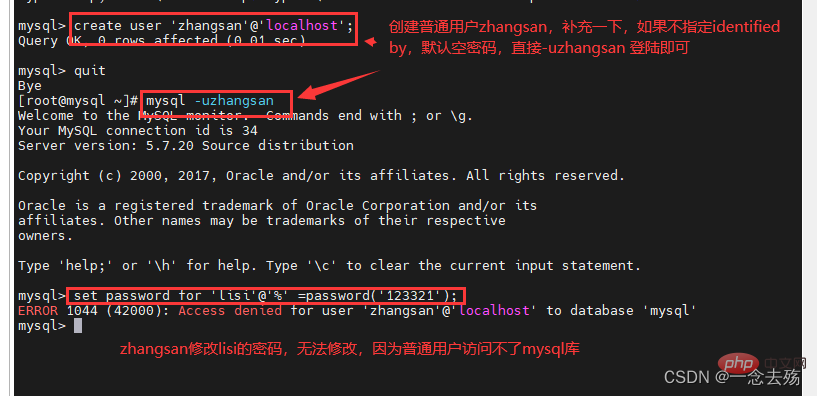
 ##1.6 What to do if you forget your password
##1.6 What to do if you forget your password
vim /etc/my.cnf #修改mysql配置文件
[mysqld]
......
skip-grant-tables #在mysqld模块下添加该配置
wq保存退出
systemctl restart mysqld #重启mysql服务
mysql #mysql直接登录
update mysql.user set authentication_string = password('新密码') where User='root';
flush privileges;
退出重新登陆
切记:修改完后一定将配置文件的skip-grant-tables注释或者删掉,不然再执行一次重启数据库,还是可以无密码登录,很危险Copy after login
vim /etc/my.cnf #修改mysql配置文件
[mysqld]
......
skip-grant-tables #在mysqld模块下添加该配置
wq保存退出
systemctl restart mysqld #重启mysql服务
mysql #mysql直接登录
update mysql.user set authentication_string = password('新密码') where User='root';
flush privileges;
退出重新登陆
切记:修改完后一定将配置文件的skip-grant-tables注释或者删掉,不然再执行一次重启数据库,还是可以无密码登录,很危险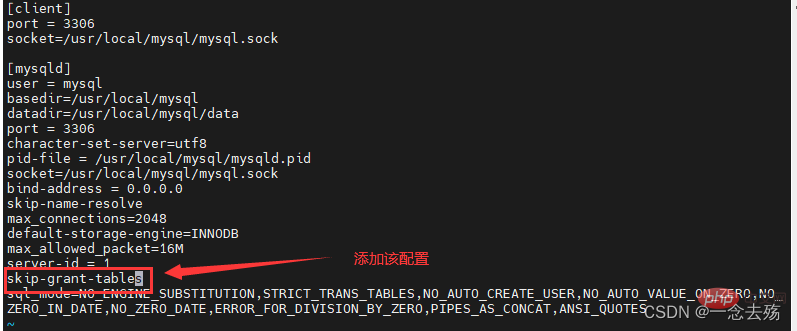
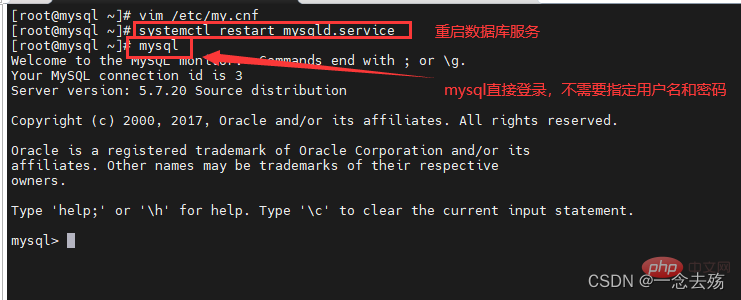
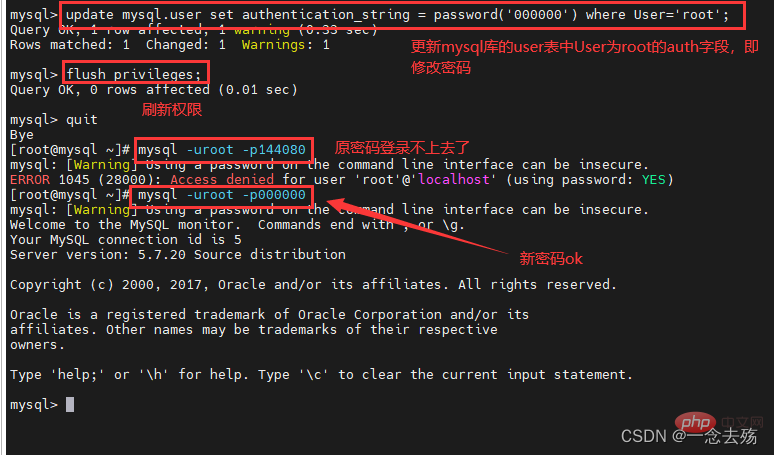

二、授权
2.1 用户授权
grant,授权,通常用于root用户授予普通用户一些执行权限,比如select,insert,update。
grant 权限列表(select|insert|delete|drop|update等等)on 数据库名.表名(*表示所有) to '用户名'@'主机名' [identified by '密码']; 若授权的用户不存在,mysql会先创建一个用户,然后进行授权操作
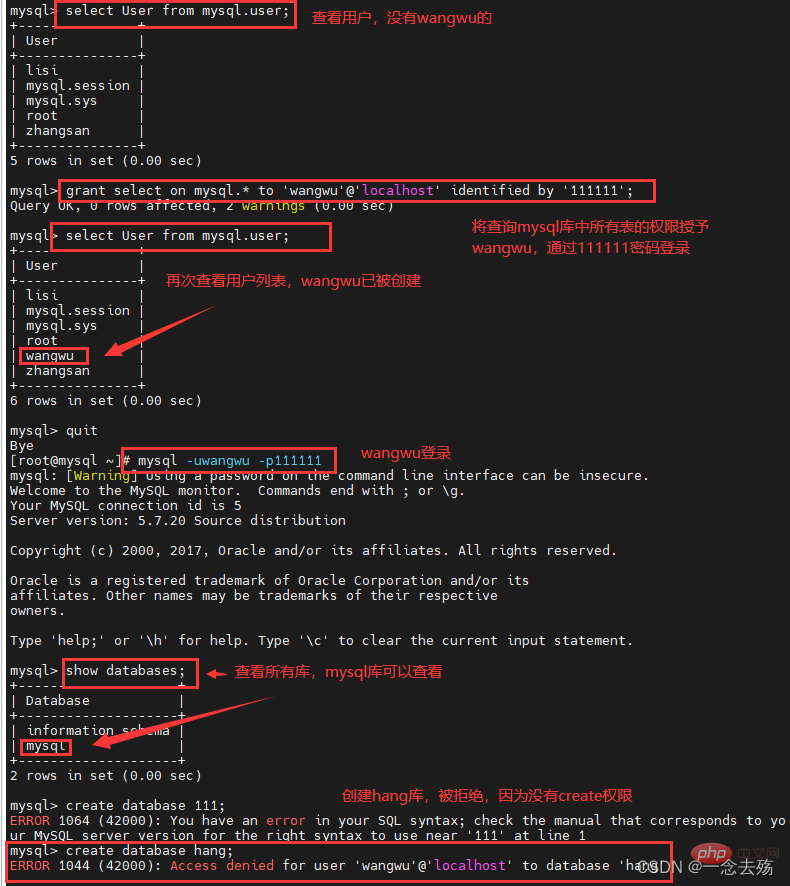
2.2 查看所授予的权限
show grants for '用户名'@'主机名'; #查看指定用户的权限show grants; #查看当前用户权限
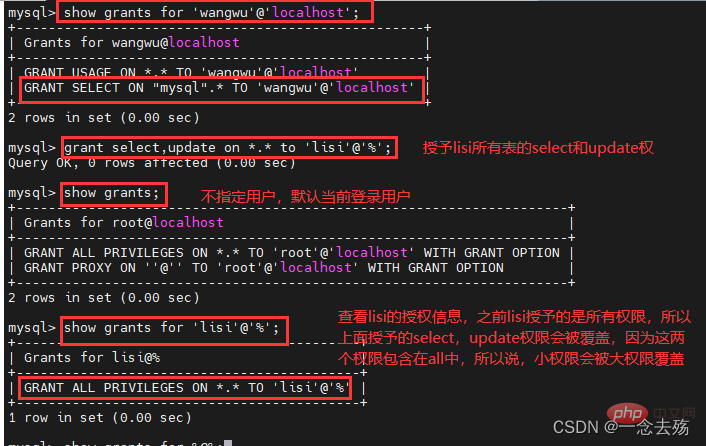
2.3 撤销权限
revoke 权限列表 on 库名.表名 from '用户名'@'主机名'; #从用户XXX撤销XX库.XX表的XX操作的权限
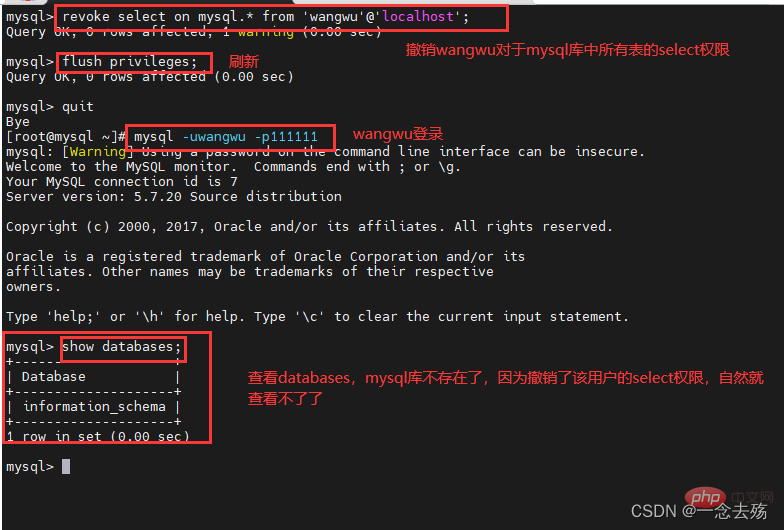
推荐学习:mysql视频教程
The above is the detailed content of Graphical examples analyzing MySQL user management. For more information, please follow other related articles on the PHP Chinese website!

Hot AI Tools

Undresser.AI Undress
AI-powered app for creating realistic nude photos

AI Clothes Remover
Online AI tool for removing clothes from photos.

Undress AI Tool
Undress images for free

Clothoff.io
AI clothes remover

Video Face Swap
Swap faces in any video effortlessly with our completely free AI face swap tool!

Hot Article

Hot Tools

Notepad++7.3.1
Easy-to-use and free code editor

SublimeText3 Chinese version
Chinese version, very easy to use

Zend Studio 13.0.1
Powerful PHP integrated development environment

Dreamweaver CS6
Visual web development tools

SublimeText3 Mac version
God-level code editing software (SublimeText3)

Hot Topics
 1653
1653
 14
14
 1413
1413
 52
52
 1304
1304
 25
25
 1251
1251
 29
29
 1224
1224
 24
24
 MySQL's Role: Databases in Web Applications
Apr 17, 2025 am 12:23 AM
MySQL's Role: Databases in Web Applications
Apr 17, 2025 am 12:23 AM
The main role of MySQL in web applications is to store and manage data. 1.MySQL efficiently processes user information, product catalogs, transaction records and other data. 2. Through SQL query, developers can extract information from the database to generate dynamic content. 3.MySQL works based on the client-server model to ensure acceptable query speed.
 How to start mysql by docker
Apr 15, 2025 pm 12:09 PM
How to start mysql by docker
Apr 15, 2025 pm 12:09 PM
The process of starting MySQL in Docker consists of the following steps: Pull the MySQL image to create and start the container, set the root user password, and map the port verification connection Create the database and the user grants all permissions to the database
 Laravel Introduction Example
Apr 18, 2025 pm 12:45 PM
Laravel Introduction Example
Apr 18, 2025 pm 12:45 PM
Laravel is a PHP framework for easy building of web applications. It provides a range of powerful features including: Installation: Install the Laravel CLI globally with Composer and create applications in the project directory. Routing: Define the relationship between the URL and the handler in routes/web.php. View: Create a view in resources/views to render the application's interface. Database Integration: Provides out-of-the-box integration with databases such as MySQL and uses migration to create and modify tables. Model and Controller: The model represents the database entity and the controller processes HTTP requests.
 Solve database connection problem: a practical case of using minii/db library
Apr 18, 2025 am 07:09 AM
Solve database connection problem: a practical case of using minii/db library
Apr 18, 2025 am 07:09 AM
I encountered a tricky problem when developing a small application: the need to quickly integrate a lightweight database operation library. After trying multiple libraries, I found that they either have too much functionality or are not very compatible. Eventually, I found minii/db, a simplified version based on Yii2 that solved my problem perfectly.
 Laravel framework installation method
Apr 18, 2025 pm 12:54 PM
Laravel framework installation method
Apr 18, 2025 pm 12:54 PM
Article summary: This article provides detailed step-by-step instructions to guide readers on how to easily install the Laravel framework. Laravel is a powerful PHP framework that speeds up the development process of web applications. This tutorial covers the installation process from system requirements to configuring databases and setting up routing. By following these steps, readers can quickly and efficiently lay a solid foundation for their Laravel project.
 How to install mysql in centos7
Apr 14, 2025 pm 08:30 PM
How to install mysql in centos7
Apr 14, 2025 pm 08:30 PM
The key to installing MySQL elegantly is to add the official MySQL repository. The specific steps are as follows: Download the MySQL official GPG key to prevent phishing attacks. Add MySQL repository file: rpm -Uvh https://dev.mysql.com/get/mysql80-community-release-el7-3.noarch.rpm Update yum repository cache: yum update installation MySQL: yum install mysql-server startup MySQL service: systemctl start mysqld set up booting
 MySQL and phpMyAdmin: Core Features and Functions
Apr 22, 2025 am 12:12 AM
MySQL and phpMyAdmin: Core Features and Functions
Apr 22, 2025 am 12:12 AM
MySQL and phpMyAdmin are powerful database management tools. 1) MySQL is used to create databases and tables, and to execute DML and SQL queries. 2) phpMyAdmin provides an intuitive interface for database management, table structure management, data operations and user permission management.
 Centos install mysql
Apr 14, 2025 pm 08:09 PM
Centos install mysql
Apr 14, 2025 pm 08:09 PM
Installing MySQL on CentOS involves the following steps: Adding the appropriate MySQL yum source. Execute the yum install mysql-server command to install the MySQL server. Use the mysql_secure_installation command to make security settings, such as setting the root user password. Customize the MySQL configuration file as needed. Tune MySQL parameters and optimize databases for performance.






